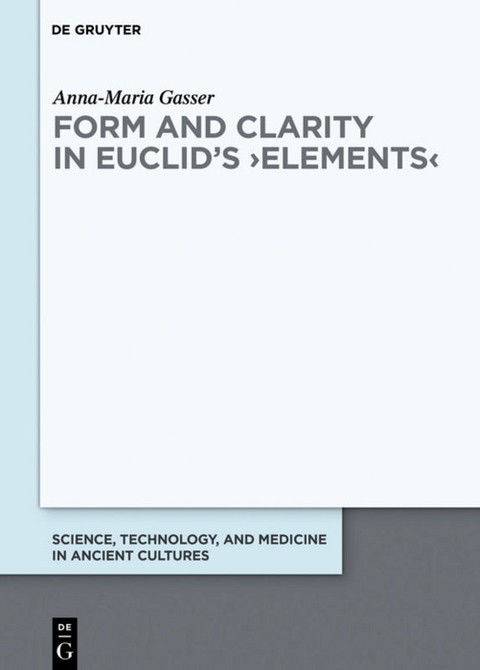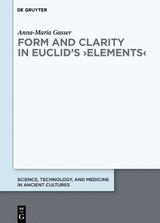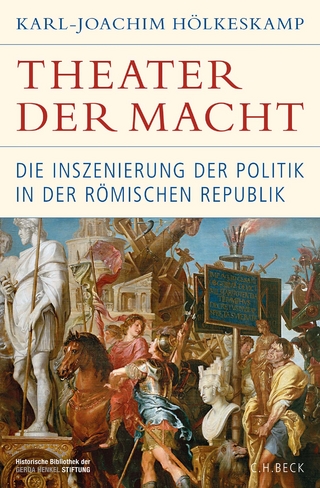Form and Clarity in Euclid’s ›Elements‹
Seiten
STMAC aims to advance an inter-disciplinary and inclusive approach to the study of science in the ancient world, ranging from mathematics and physics, medicine and magic to astronomy, astrology, and divination and covering the Mediterranean world, the Near (Middle) East, and Central and East Asia. The series is open to different types of publications including monographs and edited volumes as well as text editions and commentaries.
As of yet, the remarkable and highly influential textual form of Euclidean mathematics has not been considered from a literary-aesthetic perspective. By its extreme standardization and seeming non-literariness it appears to defy such an approach. This book nonetheless attempts precisely a literary-aesthetic study of the language and style of Euclid’s Elements, focusing on book I. It aims to find out what is literary about the form and what motivates this form as form. In doing so, it employs the concept of clarity, asking: How is the textual form related to logical and communicative clarity? That is, how far is the omnipresent standardization necessary for the accomplishment and successful communication of the proofs? Based on a close analysis of the standardization at all levels of the text (lexicon, grammar, structure, and especially diagram), it argues that the textual form of the Elements is standardized beyond logical-communicative purposes, and that it is in this sense ‘aesthetic’. The book exposes the unexpected literary dimension of Euclid’s Elements, provides a new interpretation of the peculiar form of the work, and offers a model for determining the role of clarity (not only) in Greek theoretical mathematics.
As of yet, the remarkable and highly influential textual form of Euclidean mathematics has not been considered from a literary-aesthetic perspective. By its extreme standardization and seeming non-literariness it appears to defy such an approach. This book nonetheless attempts precisely a literary-aesthetic study of the language and style of Euclid’s Elements, focusing on book I. It aims to find out what is literary about the form and what motivates this form as form. In doing so, it employs the concept of clarity, asking: How is the textual form related to logical and communicative clarity? That is, how far is the omnipresent standardization necessary for the accomplishment and successful communication of the proofs? Based on a close analysis of the standardization at all levels of the text (lexicon, grammar, structure, and especially diagram), it argues that the textual form of the Elements is standardized beyond logical-communicative purposes, and that it is in this sense ‘aesthetic’. The book exposes the unexpected literary dimension of Euclid’s Elements, provides a new interpretation of the peculiar form of the work, and offers a model for determining the role of clarity (not only) in Greek theoretical mathematics.
Anna-Maria Gasser , Berlin.
| Erscheinungsdatum | 10.05.2022 |
|---|---|
| Reihe/Serie | Science, Technology, and Medicine in Ancient Cultures ; 15 |
| Zusatzinfo | 56 b/w and 3 col. ill., 1 b/w tbl. |
| Verlagsort | Berlin/Boston |
| Sprache | englisch |
| Maße | 170 x 240 mm |
| Gewicht | 935 g |
| Themenwelt | Literatur ► Märchen / Sagen |
| Geschichte ► Allgemeine Geschichte ► Altertum / Antike | |
| Schlagworte | diagram • Diagramm • Euclid • Euklid • Greek Literature • Greek mathematics • Griechische Literatur • Griechische Mathematik |
| ISBN-10 | 3-11-067033-X / 311067033X |
| ISBN-13 | 978-3-11-067033-2 / 9783110670332 |
| Zustand | Neuware |
| Haben Sie eine Frage zum Produkt? |
Mehr entdecken
aus dem Bereich
aus dem Bereich
Die unglaubliche Geschichte eines antiken Söldnerheeres
Buch | Hardcover (2022)
C.H.Beck (Verlag)
CHF 39,20
die Inszenierung der Politik in der römischen Republik
Buch | Hardcover (2023)
C.H.Beck (Verlag)
CHF 67,20




